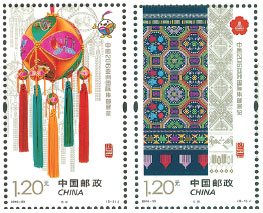Stamps tell of region's ancient past, promising future
Small as they are, postage stamps are effective showcases of the time and place they were issued, as they travel throughout the globe on mail.
A stamp usually carries images of the issuing region or country, the people, landscapes, ecology and almost all aspects of its social and economic developments.
Nanning, the capital city of Guangxi Zhuang autonomous region, will host the 2016 Asian International Stamp Exhibition from Friday to Tuesday.
This will be a showcase of the small showcases, enabling visitors to have a close look at various stamps from Asia and beyond.
Guangxi has issued a number of stamps, with the small, rectangular pieces of paper telling the history, culture, scenery and recent developments of this southernmost autonomous region in China.
A mountainous region in the south of China, Guangxi has been regarded as the frontier of Chinese civilization throughout much of it's history.
Originally inhabited by tribal groups known as the Baiyue, the region first became part of China during the Qin Dynasty (221-206 BC). It was named Xiangjun, or Elephant Prefecture, by the central government.
A milestone event for the region during this period was the construction of the Lingqu Canal, one of the earliest and most famous water diversion projects in ancient China.
The project, in today's Xing'an county in northern Guangxi was completed in 214 BC, linking the Xiangjiang, a tributary of the Yangtze River, and the Lijiang, a branch of the Pearl River.
The canal has been in service for more than 2,000 years as the major water transport route between South China and Central China, until the completion of railways linking the south and north in relatively modern times.
Today, the canal is still a multifunctional hydraulic project for irrigation, flood control, water supply and tourism.
Another example of local architectural achievement is the 64.4-meter-long Chengyang Bridge in Sanjiang county. The bridge was built relatively recently, in 1912, by the Dong ethnic group in northern Guangxi.
Also known as the Chengyang Wind and Rain Bridge, it is a combination of bridge, corridor, veranda and pavilions. The piers are made of stone, the upper structures are mainly wooden, and the roof is covered with tiles.
The roofed Wind and Rain bridge is popular among the Dong and Miao ethnic peoples scattered throughout Guangxi, Hunan and Guizhou provinces. The construction techniques are still alive among craftsmen in the region, with a number of new bridges still emerging.
The region's colorful ethnic culture is also visible in the daily life, rituals and production activities of various ethnic groups in Guangxi.
Guangxi is home to more than 15 million Zhuang people. Zhuang is the largest ethnic minority group in China, with a total population of over 16 million nationwide.
Zhuang people are renowned for their love of folk songs. Liu Sanjie was a legendary Zhuang girl with the ability to sing songs like no one else. She has been dubbed "the Song Fairy" because of her seemingly supernatural gift. Her statue is featured at the annual Zhuang folk song festival.
Liu Sanjie shared her talent all along the section of the Lijiang River stretching from Guilin to Yangshou.
Guilin is one of the most famous tourist destinations in the world. A popular Chinese saying goes, "the mountains and waters of Guilin are the finest under heaven", mostly due to its uniquely shaped karst hills and the Lijiang River, which are often portrayed in Chinese artwork.
Many fascinating caves can be easily found and explored in this area, and Guilin is the best example of karst landforms in China.
There are also postage stamps showing Guangxi's achievements in social and economic developments, as well as its international exchanges in the modern times.
One set of stamps is dedicated to the 50th anniversary of the Guangxi Zhuang autonomous region, which was celebrated in 2008.
The stamps feature images of people of various ethnic groups singing and dancing in celebration, the Nanning International Convention and Exhibition Center that has played host to the annual China-ASEAN Expo, as well as harbors along the Beibu Gulf that are now playing an increasingly important role in China's Belt and Road Initiative.
|
Stamps featuring a silk ball and Zhuang embroidery will be issued for the Nanning stamp exhibition.Provided To China Daily |
(China Daily 12/01/2016 page12)















